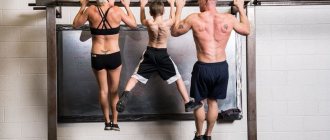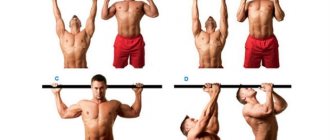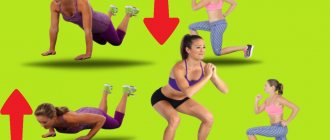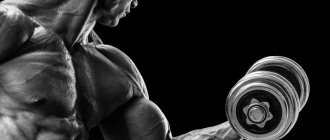Pull-ups are one of the key bodyweight exercises that are important to perform for developing upper body muscles. Being able to do a pull-up is a good assessment of your fitness and strength.
In this article we will look at an important issue: how to learn how to do pull-ups from scratch on a horizontal bar for men and women, and we will also look at the technique of doing pull-ups and useful tips on how to learn how to do pull-ups.
Is it possible to pump up on the horizontal bar?
To achieve muscle growth, you need to work hard. And yes, it is quite possible to achieve such a result on the horizontal bar if the training scheme is appropriate. The only thing that is important to immediately understand is which muscle groups the horizontal bar will help pump up.
When you pull yourself up, your biceps, shoulders, back muscles, and abs work. Grip strength, that is, the muscles of the forearm, is also well trained. Your legs are resting as if they were at a resort. You can even imitate walking while hanging - your legs will still not swing. But the abs tense well at such moments, especially the lower part.
From the back side, the latissimus, trapezius, teres and rhomboid muscles swing.
In addition, pull-ups, as well as simply hanging on a horizontal bar, are considered very beneficial for health. This position allows you to naturally straighten your spine. While you are hanging, gravity is pulling your body down. The entire back is stretched, the vertebrae are in the correct position.
By working out on the horizontal bar, you can both pump up the muscles of your back, abs and arms, and improve your own spine.
Tips for doing the exercise
There are several types of pull-up grips. The safest options suitable for beginners are:
- narrow grip - the distance between the hands is less than the width of the shoulders;
- reverse grip - palms facing you;
- neutral grip - hands on different sides of the horizontal bar in front of each other;
- straight grip - the distance between the hands and the width of the shoulders are equal.
A wide grip (when the arms are spread wider than the shoulders) is effective, allows you to pump up the upper body well, but creates a large load, and therefore is dangerous. It is not advisable to perform it without preparation.
It is important to monitor your breathing. Take a full breath while at the bottom. Full exhalation - at the highest point. The same applies to dips, whether you train every day or not: inhale while relaxing (above), exhale at maximum tension (below). Often, when beginners want to do more pull-ups, but in fact they can’t even do 10 pull-ups, the problem is improper breathing - it reduces endurance.
We should strive not to do as much as possible, but to do it right. Progress in pull-ups is slow, this is normal, there is no need to chase records.
You also need to alternate grips to load different muscle groups, giving them alternate rest. Different grips use specific muscles:
| Type of grip | Main working muscles |
| Straight narrow | Serrated, shoulder, lat bottom |
| Straight classic | Full chest, back, shoulders |
| Reverse classic | Biceps, lats |
| Reverse narrow | Lower lats, biceps |
| Wide classic | Trapezoidal, top of lats, round |
| Wide with head care | Top and middle of lats, trapezoidal, round |
| Neutral | Shoulders, lats, serratus |
Under no circumstances should you jerk, twist, sway, throw back your head, or squeeze your shoulders. This leads to injuries to the vertebrae and muscles. Any pull-ups are performed smoothly, only the elbows move, and the body is vertical.
Thus, in the question of whether it is possible to do pull-ups every day, the main thing is rationality and attention to body signals. It is not advisable to train every day, and absolutely not for beginners. However, if an irresistible craving arises, then at least there is no need to turn classes into an endless marathon.
Straight narrow Straight classic
Reverse classic
Reverse narrow
Wide classic
Wide with head care
Neutral
How to gain weight using a horizontal bar?
The answer to this question is very simple, and, in fact, is no different from gaining weight in the gym - you need to work with weights. How to do this, what weights to work with - we will analyze in detail in the next paragraph using specific examples. To achieve a good result, you need a well-thought-out training scheme.
Just like in the gym, you need to exercise correctly on the horizontal bar. It is advisable that the program be compiled by a qualified specialist, and not by a nameless trainer from the nearest basement “rocking room”. An inexperienced coach “points his finger at the sky.” His program may be effective, or it may be a failure. The optimal result will be achieved by an individual training scheme tailored specifically for you.
Of course, there are general principles of weight gain that will be useful to everyone:
- In order to increase muscle mass on the horizontal bar, you need to perform 4-6 sets of exercises, 6-8 repetitions. The last repetition should be practically a failure. If you can easily do more, add weight. You should not do 10 or more repetitions. A high-repetition program will help you increase your endurance and lose weight, but it won't help you gain weight.
- Rest between sets – as much as your body requires, since you are working “to failure”. But no more than 3 minutes. Between exercises - exactly the same.
If you adhere to strict time limits, you will not be able to fully complete the second and subsequent approaches. For example, 1 minute is too short a period to restore strength and muscles after a full approach.
Basic mistakes
There are factors that interfere with the process of mastering the projectile. These include:
- Excess weight. If you are overweight, more muscle effort is required to pull up. If your weight exceeds the norm by 20 kilograms or more, then first of all you need to get your shape in order.
- Problems with the cardiovascular system. In a person with a weak heart and blood vessels, when performing an exercise, the blood simply does not have time to pass through the narrow capillaries. As a result, the pressure jumps, the head feels dizzy, and the vision becomes dark. Agree, this greatly interferes with the normal flow of training.
- Poor physical shape. Pull-ups are not given to those who do not have endurance and physical strength.
- Muscle weakness. When performing an exercise, various muscle groups are involved; if some of them are too weak, mastering the exercise may be in question. The success of the event largely depends on the training of small auxiliary muscles, which are not strong enough for most novice athletes.
- Incorrect execution. Pull-ups on a horizontal bar are a complex technique that has its own rules. If you do not take this point into account, you can simply try to sway and shake your body a lot in the hope of getting results. Of course, nothing will work out.
- Lack of practical skills, which leads to inconsistency in the functioning of the nervous and muscular systems. Due to lack of practice, the muscles start working late and inconsistently, although they receive commands from the central nervous system. How to fix it? Train, but only do it according to all the rules.
Technical points
Pull-ups must be performed using correct technique. Let's remember once again what it is:
- If you are hanging on a horizontal bar, it is advisable not to swing from side to side.
- All movements occur due to muscles, and not due to inertia or jerking. Even if you decide to work “in the negative,” there is no point in rising above the bar using a jerk.
- You should breathe so that you rise as you exhale, and as you inhale you go down. It is physiologically correct to make an effort while exhaling.
- If you start to sway during the exercise, which happens, do not continue the pull-up until your body stops swaying.
- Each hand position on the horizontal bar is designed to load a specific muscle group. Therefore, your task is to understand well what exactly you are pumping and try to work the right muscles while performing the exercise. For example, you can pump your biceps on the horizontal bar, or you can pump your back. By training your biceps, your total mass will not increase significantly. It's just a fairly small muscle. But by building up the large back muscles, this can be achieved. Therefore, focus specifically on the latissimus dorsi muscles. The biceps should be loaded last (that is, at the end of the workout).
Exercises to learn how to do pull-ups
How to learn to do pull-ups on a horizontal bar from scratch at home? Very easy, just follow our recommendations and you will be able to pull yourself up in less than a month.
Use this manual as follows:
- If you have already started training and tried to do pull-ups, then choose exercises from the chapter that matches your level of training.
- If you want to learn how to do pull-ups and are already able to do the exercises from the “Advanced Level” chapter, then proceed to the section “5 Phases for Gradual Progression to Pull-Ups.”
Remember that although we have divided the exercises into groups according to their difficulty, you can still benefit from any of them regardless of your fitness level. When deciding how to learn how to do pull-ups on a horizontal bar, the main task is to develop the strength of the necessary muscle groups.
First level
Holding dumbbells
Stand straight with your feet hip-width apart. Take dumbbells in your hands and lower them to your sides along your torso. Keep your back straight. Hold the dumbbells by squeezing your biceps, rather than just holding them with your arms extended. Do the exercise for 30 seconds. If you find it difficult, use a lighter weight. Rest for 60 seconds. Repeat 3 times.
To further improve your grip strength, hold the dumbbells by the discs instead of the handles for 30 seconds.
Hanging on the bar
Grab the bar with an overhand grip, lift your feet off the floor and hang from it. Keep your core muscles tight. You can rotate your shoulders, trying to pull them down (rather than pushing them toward your neck) to bring your shoulder blades together. Keep your shoulder blades straight by engaging your back muscles. Repeat the exercise 5 times.
Reduction of shoulder blades while hanging
Grab the bar with an overhand grip and lift your feet off the floor. Lower your shoulders and squeeze your shoulder blades together. Relax and return your shoulder blades to their previous position. Repeat 15 times.
Pro tip: Do this exercise by imagining that you have someone's finger between your shoulder blades and trying to squeeze it with them. You'll be pulling your shoulders back slightly, but do this movement by also engaging your back muscles, not just your shoulders.
Incline dumbbell row
Hold dumbbells in each hand. Lie face down on an incline bench. The head should hang over the edge of the bench. Place your feet on both sides of the bench, relax and slightly bend your knees. Keeping your elbows close to your body, pull the dumbbells up (as if you were rowing an oar), squeezing your shoulder blades together. The dumbbells should be in line with your chest or waist, not your armpits. Hold this position for 10 seconds. Repeat 5 times.
Average level
Plank
Take a lying position. Your palms should be directly under your shoulders. Straighten your legs and place them hip-width apart. Tighten your core and keep your body straight from head to toe. Don't let your hips sag or rise up! Hold the position for 60 seconds. Rest. Do it 3 times.
"Boat" on the back
Lie face up on the floor, straighten your legs, stretch your arms back behind your head. Tighten your abdominal muscles and, without lifting your lower back from the floor, lift your arms, head and legs up. Hold the position for 15 seconds. Repeat 5 times.
Block row lying on a bench
Lie on an incline bench face up with your back to the cable machine. Place your feet on the floor and relax. Raise your arms above your head and grasp the handle of the machine. Keeping your arms straight, squeeze your shoulder blades together and pull the handle down towards your chest. Slowly return your hands to the starting position. Do 15 reps.
Holding load rims
Place 2 or more small weight discs together. Standing in a relaxed position with your arms at your sides, clasp them in your palms and hold for at least 30 seconds.
If you find the exercise difficult, reduce the weight. Rest for 60 seconds. Repeat 3 times.
Advanced level
Kettlebell press
Take the weight in your right hand. Bend your elbow and lift the bottom of the weight up to chest level. Slowly press the weight overhead. Do 15 reps and then switch hands.
Horizontal pull-ups
Place an empty bar on a power rack at chest level. Grab the bar with an overhand grip, place your hands shoulder-width apart and bend your elbows. Walk forward under the bar so that your body is at an angle to the floor and your face is facing up. Keeping your legs straight and your elbows close to your body, straighten your arms and lower your body down. Then, bringing your shoulder blades together, pull yourself up, moving your chest towards the bar.
Rollouts with fitball
Get on your knees, join your palms and place your hands on the fitball. Keeping your body straight from head to toe (do not lower or raise your hips) and resting your forearms on the exercise ball, slowly roll it forward. Tighten your abdominal muscles to return to the starting position. Do 15 reps.
Biceps bar raise
Grab an empty bar with an underhand grip. Keeping your elbows close to your body, do 100 biceps curls as quickly as possible while maintaining proper technique.
Mass training program
First, let's look at the exercises that will need to be performed to achieve significant muscle growth.
Wide grip pull-ups
This exercise is aimed at developing the latissimus muscles:
- Find the nearest horizontal bar. It is desirable that it be high enough. The scheme for working with weights implies a horizontal bar that is not too high, but not too low. It is important that your feet do not touch the ground, but that you can easily descend without jumping.
- Grab the bar with a wide overhand grip.
- Using the strength of your back muscles, pull your elbows toward your body, bringing your chin above the bar. Hold at the top for 1 second, slowly lower back down.
Aim to do 4 sets of 5-6 reps after warming up. To warm up, you can do pull-ups without weight 5-10 times, depending on your physical fitness.
Close-grip pull-ups
This is an important exercise for the mid back and biceps. If you pay attention, it’s much easier to pull yourself up this way than in the previous case:
- Grasp the horizontal bar with a narrow reverse grip.
- Using the strength of your back and arms, lift yourself up so that your chin is above the bar. There is no point in lingering at the top, since in this position there is no maximum muscle tension.
- Slowly lower yourself to the starting position.
You need to perform 3-4 sets of 6-8 times with weight.
Parallel grip pull-ups
To do this, you will need a horizontal ladder or a special horizontal bar with parallel handles. This is a very convenient option for pumping the lower part of the latissimus muscles.
- Grasp the cross bars of the horizontal ladder. To do this, you need to position yourself facing her side so that your head freely goes above the bars.
- Do 4 sets of 6-8 reps, pulling the bars toward your chest.
How to combine exercises for muscle growth
In order to properly pump your back muscles, it is advisable to exercise twice a week with weights.
You do wide-grip pull-ups twice a week. In one of the workouts, you need to do pull-ups with a narrow reverse grip as the second exercise, and in the second, with a parallel grip. Thus, in one workout you will have 2 exercises aimed at increasing body weight and strength.
A few words about the main thing
Problems with pulling up have been familiar to many men since school. For most, this exercise was a real problem when passing physical education standards. In fact, the task of doing 10 pull-ups would not be so difficult if the nuances of the process were correctly explained. If you were unable to pass the ill-fated standard in physical education classes, it’s time to pull up your tails. We will learn how to do pull-ups correctly, but not for a physical trainer, but to strengthen the muscles of the shoulder girdle, back and chest.
A horizontal bar is a projectile consisting of two vertical posts and a horizontal crossbar. A simple design with the right approach helps to work out the muscles of various groups and create beautiful sculpted arms and shoulders. You can train on the horizontal bar not only in the gym, but also in any yard where such equipment is available.
Choice of weights
For beginners, we do not recommend lifting weights right away. Work out with your own weight for at least a month, strengthen your muscles, and increase the number of pull-ups in one approach to at least 10–15.
Regular backpack
Once you have sufficiently strengthened your muscles by training with your own weight, you can begin training with weights.
Take an ordinary backpack and put a few bottles of water in it. Using bottles you can load up to 20 kg (provided the backpack is large enough). Instead of bottles, you can use a bag of sand or any other heavy objects.
Always start your workout with a warm-up. The scheme of work is as follows: first you do 8–10 repetitions without weight. Then you work with weights, trying to pull yourself up 6-8 times, depending on the exercise.
You can increase the weights in each approach, but it is better to work with the same weight in one workout.
Weight belt or vest
A weight belt is a regular leather belt with a rope or chain running down from it. At its free end, this chain or rope is equipped with a device through which it can be secured to a belt. Thus, pancakes are put on a rope or chain, and the free edge is fixed to the belt. When you stand up, the weight will be concentrated between your legs.
This is convenient for training with additional weights: pull-ups and dips. However, if you have a weak lower back, it is better to replace the belt with a special weighted vest.
What kind of exercise is this?
In essence, these are the same hanging lifts, only with additional weight: with a chain or belt, to which plates from a barbell or dumbbells are tied.
When can you start lifting weights? For beginners, I recommend performing rows on the bar only after fully mastering the technique. The entrance test for admission is three approaches of 12 times. Each repetition is performed “cleanly”. Avoid jerking and swinging movements of the legs. If it comes easily to you, start exercising with weights.
Techniques and types of pull-ups with weights
If you have learned the technique without weights, then there will be no difficulties. When working with cargo, consider the following nuances:
- Hang onto the horizontal bar from a stand without jumping.
- You can also go down through the stand.
- Eliminate rocking.
- Movements are smooth without jerking.
Use a vest as an additional load. The advantage over a weightlifting belt is that it does not put pressure on the spine.
- To ensure a secure grip, dry your hands with sports magnesium.
- Put on the weights and approach the horizontal bar so that it is above your head.
- Using a wall bars or stand, carefully perform the hang.
- As you exhale, bending your arms, smoothly rise to your chest.
- Pause briefly at the top, keeping your chin above the bar.
- As you inhale, controlling the fall of your body, lower yourself to a hanging position.
In order for your joints to get used to it, plan your first sessions using negative pulls.
- Stand on the bench so that your chin is above the bar.
- Bend your legs and lower yourself until your arms are almost bent at the elbows.
- Stand on the bench and take your starting position.
In addition to straight ones, when the crossbar touches the chest, pull-ups by the head are no less effective. I don't recommend it for beginners. Contraindicated for diseases of the cervical and shoulder girdle.
The benefits and harms of pull-ups
Minimize the risk of harm to health by visiting a therapist first. If pathologies are detected, the doctor will develop a special program. Doctors do not always recommend hanging and doing pull-ups on an apparatus for people who have problems with the spine.
Positive sides:
- Correct posture.
- Prevention of spinal diseases.
- Muscle tone.
- Fast calorie burning.
Contraindications
The following health problems may interfere with exercise:
- Chronic diseases in acute form.
- Paralysis of arms and legs.
- Obesity.
- Heart failure.
- Poor blood flow to the brain.
- The presence of a hernia or protrusion.











